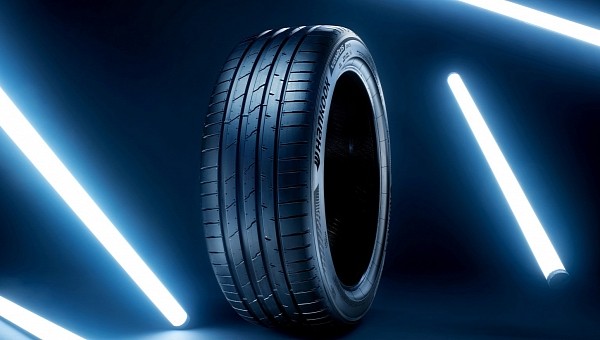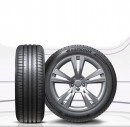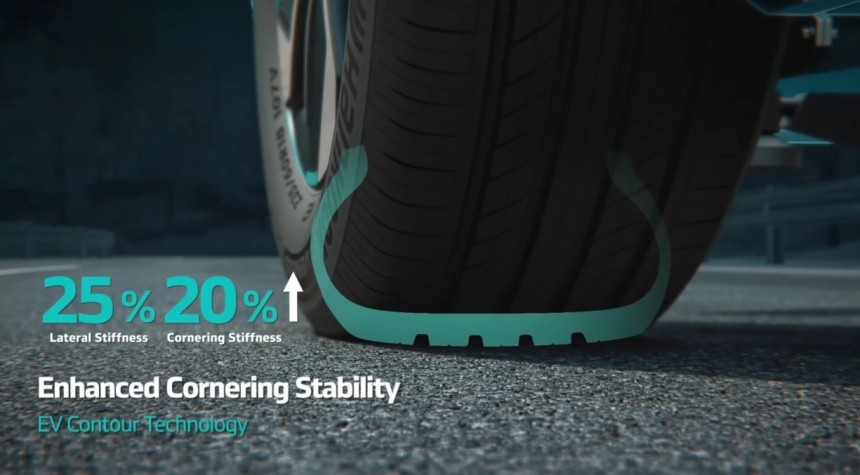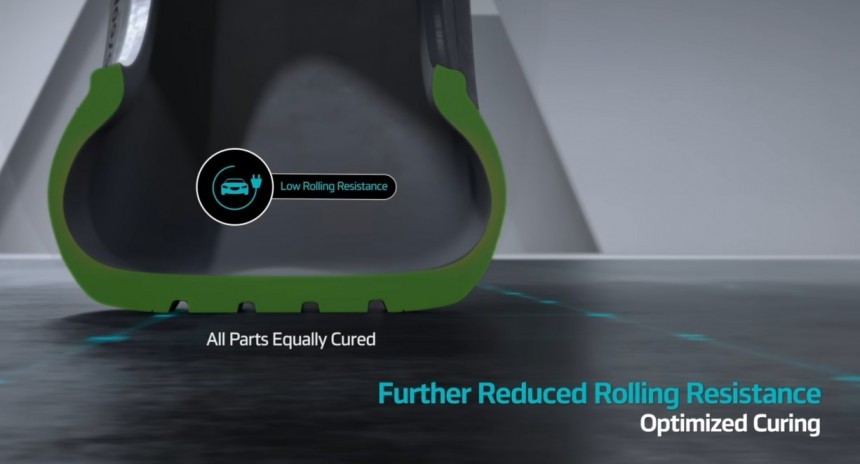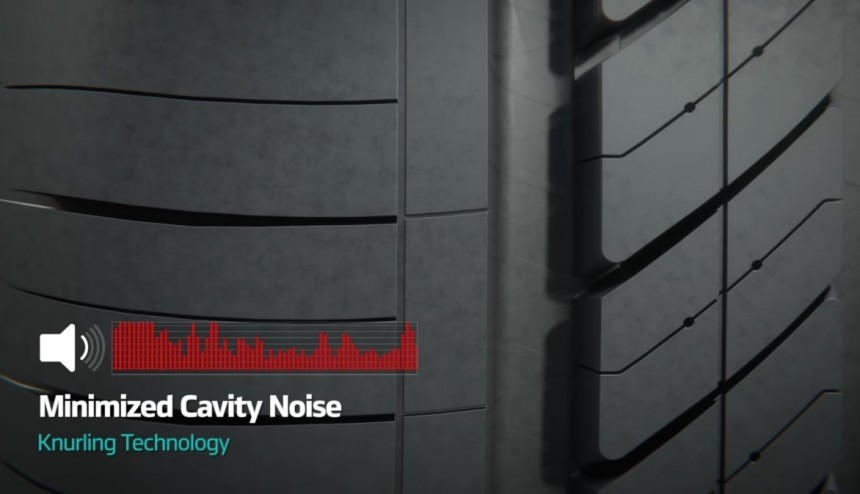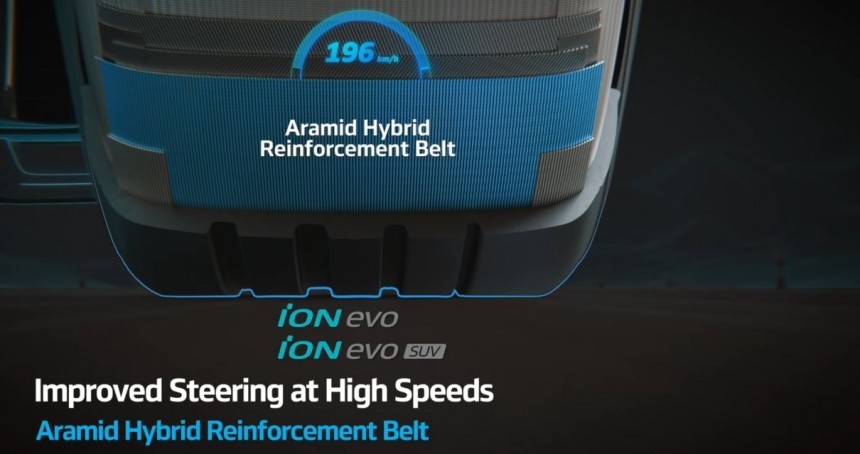Tires are one of the most important bits that help our cars take us where we need to go. And even if we take the time to look for the right tire, we rarely, if ever, think about how they actually work.
With electric cars becoming increasingly popular, we’re going to look at what kind of tires they use and how they differ in design from the ones we put on gas-powered vehicles. But before we go into that, we must first mention what challenges those “shoes” face. They must deal with the added weight of electric cars, be efficient, quiet, and able to put down the massive instantaneous torque EVs have.
So, that means we get a high load placed on a narrow surface since EV tires also have to be aerodynamic and efficient. According to some studies, the same tire would wear out 20% faster on an EV compared to a gas-powered car.
Consequently, the stiffness of the tire has to be increased, especially when it comes to the lateral load that gets placed on the tire while cornering. Hankook is one company that has done a great job here, with their iON range of EV tires having 25% better lateral stiffness. Another aspect that helps with the expected mileage of EV tires is their contact patch, which is flatter, helping spread the load more evenly across it.
However, the compound itself is just as important, as a stiffer compound will increase the life span of the tires. Things are tricky as far as this topic is concerned since no manufacturer is willing to divulge its secret. But we do know that EV tire compounds contain raw materials such as high-loading resin and silica.
To put this into perspective, the tire must match the application. Place an EV tire on a combustion engine car, and you will sacrifice comfort, but place a normal tire on an EV, and you will sacrifice handling and durability.
Just think about how easy it is to make a fuel tank slightly bigger compared to adding another hundred pounds (roughly 40kg) of batteries. So, one can easily understand why this loop of self-sabotage must be avoided. Put in numbers, the difference between an average tire and a good one could be as much as 30 miles of range.
Most of the improvement in rolling resistance comes from the processes of curing and vulcanizing the tires. First, let's start with vulcanizing. That's the process of heating rubber in the presence of sulfur to form a compound. Natural rubber reacts badly to temperature variations and is not durable, so this process is highly important. Add to that that the process is highly complex. Perfect homogeneity is hard to obtain, and a lot of research goes into what additional substances are compounded into the mixture.
Then there's curing the tire, which means heating the tire while applying pressure on it inside a mold. This not only gives the tire its final shape but also ensures a good bond between it and the reinforcing composites within the structure. Understandably, this is another complex can of worms, where each company works on developing a perfect process.
But there is one more aspect that might sound counterintuitive for anybody without an engineering degree, so allow me to explain. Remember that bigger contact patch we mentioned? One would naturally think that it would increase the rolling resistance, but it’s negligible. More important, a bigger contact patch allows the pressure to be more evenly distributed across it, which lowers the aforementioned resistance.
Surprisingly enough, quite a lot. There are a couple of features that contribute to sound and vibration absorption. Let’s start on the outside, with a really cool feature, once again found on Hankook’s iON tires. Inside the water channels, there is a zig-zag pattern that helps break up and absorb the resonance generated within the groove.
Another exterior feature of EV tires is the presence of expanding lateral grooves, which start out narrow and expand toward the outside of the tire. That design is meant to let water escape while preventing the noise from doing the same thing.
There is also something called multi-pitch sequencing, which sounds like what a musician would use to make a catchy song. However, what it means is that the lateral grooves are unevenly spaced. This disrupts the consistent rhythmic nature of the noise. Through some clever engineering, this design can even be optimized to reduce overall noise.
On the other hand, the inside of the tires does not have as many innovations. Still, there is a foam insert that helps absorb the vibration generated by the rolling of the tires. Consequently, this prevents that vibration from traveling up the wheel, through the suspension, and into the chassis and cabin. As tested in the video below, a simple tire switch accounted for a 3dB decrease in overall noise, which is a difference of about 25%.
But there's also the issue of stopping that added weight, so EV tires must be able to provide as much longitudinal grip as possible, whether accelerating or decelerating. This takes us back to stiffness, and there are a few tricks used in EV tires.
The most important part is the internal structure. Jointless bead wires (which help the tire remain attached to the wheel in high load scenarios), folded edge tape (which helps with reinforcing the sidewall), and a high-strength steel belt (meant for impact absorption) are among the technologies that contribute to this. Along with a layer of fiber structure stiffener (with an important role in sidewall rigidity) and the tire compound itself, these factors provide an increase in rigidity. The other key feature of EV tires is their wide central rib pattern, which allows the tire to benefit from increased traction.
However, there are a couple of caveats. EV tires are considerably more expensive, with prices for some models exceeding $300 per tire, similar to what you'd normally pay for something used on a high-end sportscar or luxury vehicle. Even so, they will still wear out faster than those on gas-powered cars.
But that is because they have to work harder, and if that level of stress is placed on a normal tire, there will be consequences. Those can range from lower braking performance and higher wear rates all the way to the tire giving way and blowing up.
One solution would be to use run-flat tires. However, that's not advised either, as they not only add unnecessary weight but are also not designed for the job. Although they do benefit from a reinforced sidewall, similar to EV tires, their structure is not designed to support the increased mass of an EV. Keep in mind we also mentioned traction and the importance of the contact patch, which are also not factored in when companies design normal run-flat tires.
So despite there being a temptation to cheap out, the downsides are not worth it, especially considering more and more affordable EV tires are going to pop up on the market. That is going to create competition and, soon, lower the average price of EV tires with a decent performance.
Weight
We’ll start off with the most obvious factor, weight. Unsurprisingly, electric cars are heavy, having to lug around a few hundred pounds worth of batteries, often over 1,000 (400kg). Compare that to the less than 100 pounds a gas-powered vehicle needs to achieve a similar gold standard range of 300 miles (483 km), and even with the poounds saved by using an electric motor, the overall weight is still higher.So, that means we get a high load placed on a narrow surface since EV tires also have to be aerodynamic and efficient. According to some studies, the same tire would wear out 20% faster on an EV compared to a gas-powered car.
Consequently, the stiffness of the tire has to be increased, especially when it comes to the lateral load that gets placed on the tire while cornering. Hankook is one company that has done a great job here, with their iON range of EV tires having 25% better lateral stiffness. Another aspect that helps with the expected mileage of EV tires is their contact patch, which is flatter, helping spread the load more evenly across it.
However, the compound itself is just as important, as a stiffer compound will increase the life span of the tires. Things are tricky as far as this topic is concerned since no manufacturer is willing to divulge its secret. But we do know that EV tire compounds contain raw materials such as high-loading resin and silica.
To put this into perspective, the tire must match the application. Place an EV tire on a combustion engine car, and you will sacrifice comfort, but place a normal tire on an EV, and you will sacrifice handling and durability.
Efficiency
This is one of the most crucial aspects when it comes to electric vehicles. When it comes to tires, this is reflected in their coefficient of rolling resistance. Here, small changes can lead to a big impact since being less efficient means a bigger battery is needed, which in turn adds more weight and decreases efficiency further.Just think about how easy it is to make a fuel tank slightly bigger compared to adding another hundred pounds (roughly 40kg) of batteries. So, one can easily understand why this loop of self-sabotage must be avoided. Put in numbers, the difference between an average tire and a good one could be as much as 30 miles of range.
Most of the improvement in rolling resistance comes from the processes of curing and vulcanizing the tires. First, let's start with vulcanizing. That's the process of heating rubber in the presence of sulfur to form a compound. Natural rubber reacts badly to temperature variations and is not durable, so this process is highly important. Add to that that the process is highly complex. Perfect homogeneity is hard to obtain, and a lot of research goes into what additional substances are compounded into the mixture.
Then there's curing the tire, which means heating the tire while applying pressure on it inside a mold. This not only gives the tire its final shape but also ensures a good bond between it and the reinforcing composites within the structure. Understandably, this is another complex can of worms, where each company works on developing a perfect process.
But there is one more aspect that might sound counterintuitive for anybody without an engineering degree, so allow me to explain. Remember that bigger contact patch we mentioned? One would naturally think that it would increase the rolling resistance, but it’s negligible. More important, a bigger contact patch allows the pressure to be more evenly distributed across it, which lowers the aforementioned resistance.
Noise
As EVs don’t have any sort of controlled explosion going on under the hood, they are much quieter. This, in turn, means that any other noise immediately becomes more noticeable. So what can tire makers do?Surprisingly enough, quite a lot. There are a couple of features that contribute to sound and vibration absorption. Let’s start on the outside, with a really cool feature, once again found on Hankook’s iON tires. Inside the water channels, there is a zig-zag pattern that helps break up and absorb the resonance generated within the groove.
Another exterior feature of EV tires is the presence of expanding lateral grooves, which start out narrow and expand toward the outside of the tire. That design is meant to let water escape while preventing the noise from doing the same thing.
There is also something called multi-pitch sequencing, which sounds like what a musician would use to make a catchy song. However, what it means is that the lateral grooves are unevenly spaced. This disrupts the consistent rhythmic nature of the noise. Through some clever engineering, this design can even be optimized to reduce overall noise.
On the other hand, the inside of the tires does not have as many innovations. Still, there is a foam insert that helps absorb the vibration generated by the rolling of the tires. Consequently, this prevents that vibration from traveling up the wheel, through the suspension, and into the chassis and cabin. As tested in the video below, a simple tire switch accounted for a 3dB decrease in overall noise, which is a difference of about 25%.
Torque
When it comes to torque, not only do EVs usually have more of it, but they put it down way faster than their gas-powered counterparts. Thanks to the batteries, there is some added weight, which gives the car more mechanical grip, in turn helping acceleration.But there's also the issue of stopping that added weight, so EV tires must be able to provide as much longitudinal grip as possible, whether accelerating or decelerating. This takes us back to stiffness, and there are a few tricks used in EV tires.
The most important part is the internal structure. Jointless bead wires (which help the tire remain attached to the wheel in high load scenarios), folded edge tape (which helps with reinforcing the sidewall), and a high-strength steel belt (meant for impact absorption) are among the technologies that contribute to this. Along with a layer of fiber structure stiffener (with an important role in sidewall rigidity) and the tire compound itself, these factors provide an increase in rigidity. The other key feature of EV tires is their wide central rib pattern, which allows the tire to benefit from increased traction.
Conclusion
Despite the challenges posed by the traditional characteristics of electric vehicles, there are solutions and combining them leads to a great outcome. Technology is always improving, and if taken into account when designing the tire, the challenges which we spoke about can be overcome.However, there are a couple of caveats. EV tires are considerably more expensive, with prices for some models exceeding $300 per tire, similar to what you'd normally pay for something used on a high-end sportscar or luxury vehicle. Even so, they will still wear out faster than those on gas-powered cars.
But that is because they have to work harder, and if that level of stress is placed on a normal tire, there will be consequences. Those can range from lower braking performance and higher wear rates all the way to the tire giving way and blowing up.
One solution would be to use run-flat tires. However, that's not advised either, as they not only add unnecessary weight but are also not designed for the job. Although they do benefit from a reinforced sidewall, similar to EV tires, their structure is not designed to support the increased mass of an EV. Keep in mind we also mentioned traction and the importance of the contact patch, which are also not factored in when companies design normal run-flat tires.
So despite there being a temptation to cheap out, the downsides are not worth it, especially considering more and more affordable EV tires are going to pop up on the market. That is going to create competition and, soon, lower the average price of EV tires with a decent performance.
